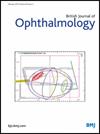Augmented medial rectus recession versus botulinum toxin therapy for acute acquired comitant esotropia: analysis of outcomes and recurrence predictors
IF 3.5
2区 医学
Q1 OPHTHALMOLOGY
引用次数: 0
Abstract
Objective To compare the motor and sensory outcomes and quality of life (QOL) of augmented medial rectus recession (aMRc) and botulinum toxin A (BTXA) therapy in acute acquired comitant esotropia (AACE) treatment and to investigate the predictors of recurrence. Methods We conducted a prospective, non-randomised clinical trial that enrolled 63 AACE patients with a disease course of 6 months to 2 years and deviation angles of 15 to 60 prism diopters. The patients were assigned to BTXA (n=31) and aMRc group (n=32). We compared and analysed the deviation angles, fusion amplitudes (FA) of convergence and divergence, stereopsis, and scores of QOL and diplopia between the two groups before treatment and at 2, 4, 6 and 12 months post-treatment. Results Both groups exhibited significant improvements in motor and sensory outcomes. The aMRc group showed more stable and satisfactory deviation than the BTXA group at 6 and 12 months post-treatment, with a significant increase in divergent FA. The aMRc group achieved a higher success rate (93.75%) than the BTXA group (64.52%) 1 year post-treatment. QOL improved significantly in both groups after treatment, except for reading function in the BTXA group. Compared with the BTXA group, the aMRc group showed greater improvements in self-perception, general function, and diplopia scores (p<0.05). Survival analysis revealed a significant difference between the two groups (p=0.0046). Treatment method and convergent FA at near before treatment were identified as recurrence predictors (p=0.023 and 0.025). Conclusions Augmented MRc treatment was superior to BTXA injection in AACE patients with courses >6 months during 1-year observation, particularly in maintaining alignment, eliminating diplopia and improving divergent FA and QOL. Trial registration number ChiCTR2300068735. Data are available upon reasonable request.增强内直肌收缩与肉毒杆菌毒素治疗急性获得性共同性内斜视:结果和复发预测因素分析
目的比较增强内直肌收缩(aMRc)和肉毒毒素A (BTXA)治疗急性获得性共同性内斜视(AACE)患者的运动和感觉预后及生活质量(QOL),并探讨其复发的预测因素。方法我们进行了一项前瞻性,非随机临床试验,纳入63例AACE患者,病程为6个月至2年,偏离角度为15至60棱镜屈光度。将患者分为肉毒毒素组(n=31)和aMRc组(n=32)。比较分析两组患者治疗前及治疗后2、4、6、12个月的偏差角、会聚发散融合振幅(FA)、立体视、生活质量评分和复视评分。结果两组患者的运动和感觉功能均有显著改善。在治疗后6个月和12个月,aMRc组比BTXA组表现出更稳定和满意的偏差,发散性FA显著增加。aMRc组治疗1年后的成功率(93.75%)高于BTXA组(64.52%)。治疗后两组患者的生活质量均有显著改善,但肉毒毒素组患者的阅读功能有所改善。与BTXA组相比,aMRc组在自我知觉、一般功能和复视评分(p6个月)方面表现出更大的改善,特别是在保持直线、消除复视和改善发散FA和QOL方面。试验注册号ChiCTR2300068735。如有合理要求,可提供资料。
本文章由计算机程序翻译,如有差异,请以英文原文为准。
求助全文
约1分钟内获得全文
求助全文
来源期刊
CiteScore
10.30
自引率
2.40%
发文量
213
审稿时长
3-6 weeks
期刊介绍:
The British Journal of Ophthalmology (BJO) is an international peer-reviewed journal for ophthalmologists and visual science specialists. BJO publishes clinical investigations, clinical observations, and clinically relevant laboratory investigations related to ophthalmology. It also provides major reviews and also publishes manuscripts covering regional issues in a global context.

 求助内容:
求助内容: 应助结果提醒方式:
应助结果提醒方式:


